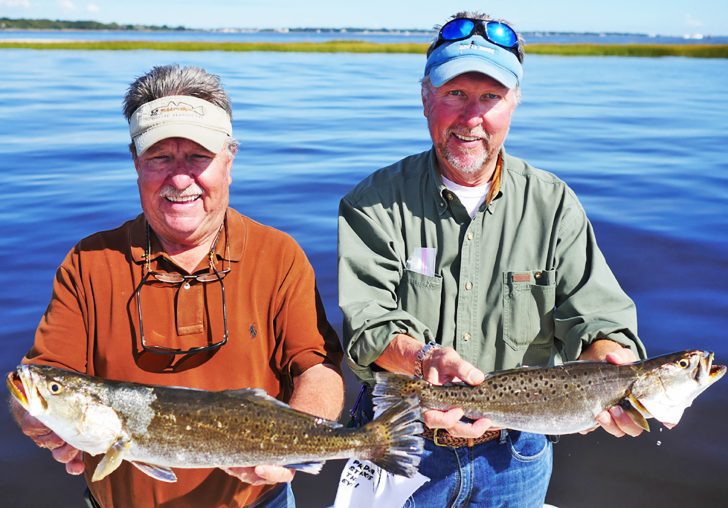For November’s article I’d like to start with a recap of the best trout fishing day I’ve ever had, and probably ever will. This particular day was two years ago in November.
My guest was Scott – one of my oldest friends who has become a skilled artificial lure angler.
We eased into a small bend in a creek and I suggested to him where to cast – a spot just up-current of a fallen down bush where I’d caught some nice fish in prior trips.
Before I could get a cast off he comes tight to a 23” trout which is a true “gator” trout, especially in Charleston.
Easily his best trout ever, we took a few pics and released her. Rather than run the trolling motor, I pulled my classic Boston Whaler up to the marsh and tied off to a clump of spartina to hold our position.
What happened next is not an exaggeration and if someone told me I would probably not believe them either!
We caught trout on almost every cast for the entire 6 hours of outgoing tide without moving. The average size was solid, maybe 16-17” with a few 18-19” thrown in.
This was probably a once-in-a-lifetime trip, but it should give you an idea of the promise that November holds for the artificial lure angler.
So, what makes November so great? I’d say that on a high level here in Charleston we have two major patterns and several more minor patterns.
The major patterns are Summer and Winter. During these times things remain stable for 2 or 3 months.
The months in between are transition months and these contain the minor patterns that change more frequently.
Speckled trout, who generally prefer salty water, start to move up the rivers and creeks seeking what food is available
The beginning of November is usually the end of the Fall transition (upper 60’s water temps) and by Thanksgiving we’re starting the Winter pattern (lower 60’s and below).
If you know me, you know that I am an engineer by trade, and you wouldn’t be surprised to know that I do geeky things like make plots of water temperature by month.
My charts tell me that by the beginning of November our water temperatures typically reach the 60’s.
By the time the water has reached these temps, most baitfish have migrated south, and forage becomes pretty scarce.
Speckled trout, who generally prefer salty water, start to move up the rivers and creeks seeking what food is available, typically smaller shrimp and glass minnows.
Because conditions change during the month, I’ll break down things to think about as we move through November.
Early in the month, it’s still a great idea to throw topwater lures. In my experience, they still work well until the water gets down into the low 60’s toward the end of the month.
Maybe try some smaller topwater profiles and work them a little more slowly. You could have luck fishing topwater pretty much any time during the day. It’s always a great idea to simply observe.
Once in November I was fishing a bank and heard a splash in the center of the creek I was in.
It was maybe 15 feet deep there but when I saw it happen a second time, I noticed some shrimp scattering. I quickly tied on a Z-Man EZ ShrimpZ and immediately started catching trout.
If you see a school of minnows get crashed, pull out a topwater plug of your choice, cast in there and hold on.
For this reason, I always have a topwater plug rigged and ready in November at all times of the day.
In November, the soft plastic and jig head are king
As the month progresses and the weather gets colder, I’m in no hurry to get out at daybreak.
I’ve had many trips where I’ve gotten out early only to cast my arm off till 10 am when everything starts warming up a bit and the bite turns on.
Now, I make some waffles or eggs and have a couple cups of coffee before heading out. I’m still catching the same amount of fish, but with a lot more rest.
In November, the soft plastic and jig head are king. Find the trout, and they bite like their life depends on it.
However, remember that trout tend to school up as the water cools so you can either be a hero or zero depending on how you approach them.
If you find the fish it can be every cast. If you don’t find them, you can get skunked. Sometimes, you can be 50 feet away from the fish and never know it.
If we’re trying to find the fish, we start up current and use our trolling motor to slow our drift and position the boat, and cast at any and all structure working all parts of the water column, but favoring the bottom portion.
By using jigs and lures we have confidence in, we feel like we will find the fish if they are there.
Once you get a bite, hit spot-lock and fan cast the area. Often this will result in a bunch of fish caught in a frenzy and then suddenly it turns off.
Another way to locate fish is to troll
Not to worry, the school simply moved. Just keep moving until you find them again. A good tactic that also works is to move away for 5 or 10 minutes and let the fish settle down, then go back and often it will be on again.
Another way to locate fish is to troll. Set up a couple rods with jigs, put them in rod holders on either side of the boat, and cast far back.
Move the boat as slowly as you can, at idle speed, and make sure the jigs are bouncing bottom.
Keep running the banks until you hook up. It’s as simple as that. You will get hung up periodically but that’s part of the game.
Ralph likes to tell this story at his seminars. He was watching an old timer troll down the bank and hook a trout. He’d unhook it and keep going.

______________________________________________________________
Then he’d turn around and come back and hook up a trout again at the same point, and so on…
Ralph idled by and the old timer says “Every time I pass this point, I get a trout!” Ralph says “Well, why don’t you stop there and keep fishing?!”
Trolling is a lot of fun in a kayak. When I used to have a vacation home on a tidal creek my son was young enough to be able to sit facing backwards on our kayak while I paddled.
I’d put two rods out trolling while he watched the rods. When a rod tip would start bobbing, he’d reel it in. Great times for father and son!
If you want to learn how to use artificial lures, this month is an excellent time to gain confidence
We had a portion of the creek we named “Snaggle-Tooth Stretch” because it was such a productive trout spot. Anyway, I digress…
Here are a couple tackle suggestions.
In this month, the colder water has killed off most of the algae and our waters clear up quite a bit.
It’s a good time to use a 20 lb fluorocarbon leader about 24 to 36” long, and of course you want to “match the hatch” by downsizing your lures.
If you stop me in the creek and check my line, I’ll probably have the Z-Man StreakZ 3.75” or a 3” Slim SwimZ in either Pearl (white) or Ralph’s Shad (named for my business Partner).
We like to pair these with our Trout Eye Finesse or Texas Eye Finesse jigheads which have a short shank, wide gap 1/0 hook.
In summary, get on the water in November. If you want to learn how to use artificial lures, this month is an excellent time to gain confidence.
As I’ve advised in part articles, remember to manage your line and fish slower. Most of all, have fun and bring a friend or family member and enjoy the best month of fishing of the year.
See you on the water!
David Fladd
Partner, Eye Strike Fishing
dfladd@eyestrikefishing.com
eyestrikefishing.com
YOU CAN COMMENT ON THIS ARTICLE BELOW!
You may also enjoy reading Small Things That Count






